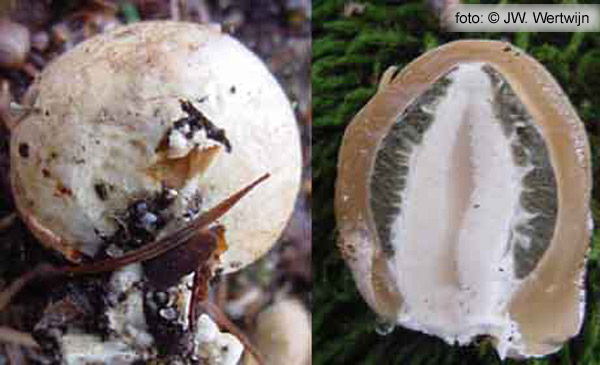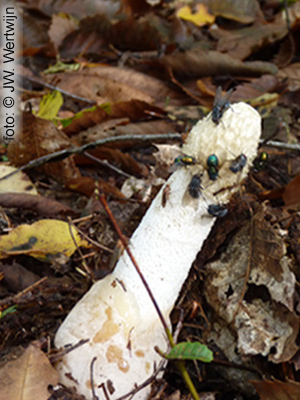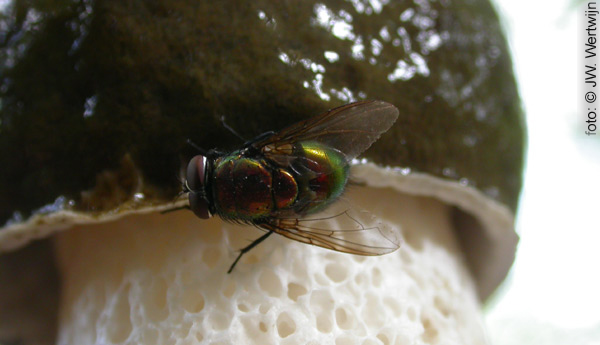|
Common stinkhorn
(Phallus impudicus)
NMV Ga 225020
Stinkhorns are stomach fungi, with very different look and feel, compared to earthstars, earthballs or puffballs.
These species propagate in two ways: by spore and by mycelium.
All in the Netherlands known species with a phalloid-shape start with an egg-shape.
They are comencing as a (generally) white, silky egg-like structure full of yelly in which is embedded
a conical cap attached only at its apex to a cylindrical white spongy, hollow stem.
During growth the egg breaks open. From thre the stem is erecting with on top a slimy spore-mass.
The spore-mass on top is olive-green or brownish, and has a strong smell. Flies like the smell, are landing on it,
and transporting the spores at their feet to different areas.
|

The so called Witches egg is young, peeled and raw, edible, and tastes like radish or turnip-cabbage.
On guided trips we normally only serve the white stuff (stem), though the rest can be eaten, too. Funny, that something can smell that bad, and tastes that good.
|

Photo: Maarn-Austerlitz, Huis de Laagt,
oktober, 1. 2010
|
In the Netherlands there are two phalloid genus of stinkhorns:
The Phallus-genus has a ribbed top,
and the Mutinus-genus
has on top a spongy structure, likely teh structure of the stem.
Wellknown species of The Phallus-genus are:
Common stinhorn (P. impudicus) with the edible witches-egg,
Dune stinhorn (P. hadriani) in sand-dunes,
and Veiled lady (P. duplicatus).
|
Regional:
Common stinkhorn is regulary observed in the Amsterdam area (het Gooi, and locally in urban area)
before 1999. It is strange, but I never found Common stinkhorn near the city, while others do.
Field attributes Common stinkhorn:
Common stinkhorn has a specific color (whitish) and posture (strong)
It has a big ei (white to yellow), a white stem, a white cap, and a baldy border of the apex on top.
The smell is disgusting and obtrusive, even if the egg is still underground.
Habitat Common stinkhorn:
Common Stinkhorn is found in the pleistocene area, in the dunal coast and in Zuid-Limburg.
Common Stinkhorn is saprotrophe at different kinds of soil, which are rich of
coarse litter and humous,
in decidious and mixed forests, also in fertile sand, sandy loam or clay.
In forests with douglas Common stinkhorn can be found, in pinus-dorests there are no Common stinkhorns.
Common stinkhorn is growing from substrate to substrate by hyphe-traces.
In the areas where Common stinkhorn can be found, Common stinkhorn is very common.
From May till December, peak in Oktober.
|
 |
 |
Other phallus-species:
Dune stinkhorn has been seen in Amsterdam, once. I never did.
Dune stinkhorn has a remarkable egg-color (lila to violet, color changes at the open air),
and the border of the apex is crenated (instead of bald). The smell is sweeter than that of Common stinkhorn,
but still disgusting and obtrusive.
Dune stinkhorn is rather rare, and can be found along the dunal coast in the Netherlands and in Belgium, in the outer dunes.
Is prefers non-humous sand, either calciferous or non-calciferous sand, in a pionier vegetarion of lyme-grass
sea buckthorns.
|
Top
|